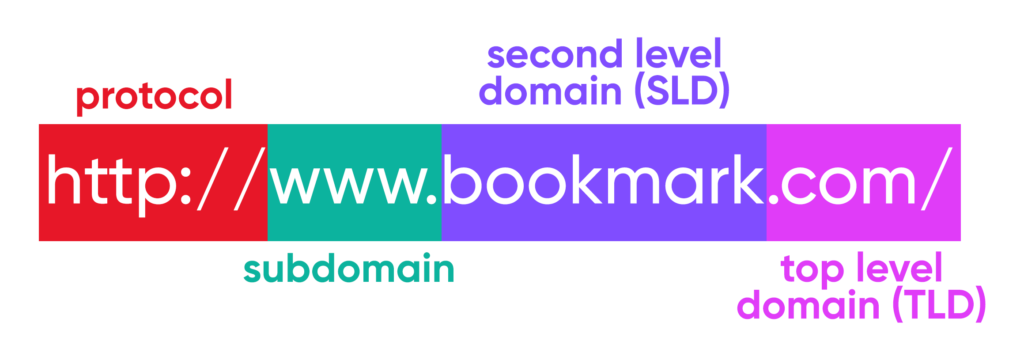One important and stressful part of planning a website is choosing the domain name. Whether it’s for your new and exciting business endeavor or a portfolio of your personal work, picking a domain name at the beginning of your journey leaves you to think, am I making the right choice?
We can all remember that first email address we created ourselves, but unfortunately a domain holds a lot more weight and isn’t as simple to change and start-over.
So where do you start? Do you pick the familiar .com? Or go with .org or .net to show off your business type?
Let’s get into the who, what, where, and why of choosing your business domain.
What even is a domain?
I enjoy imagining a website domain like a sandwich, mainly because I like sandwiches, and it helps. Domains have three distinct parts: a subdomain, a second-level domain (SLD), and a top-level domain (TLD). And when you put it together, you get your full domain name! Oh, and we also have the protocol, AKA those letters and symbols at the beginning (http://).

Are you still with me? Excellent. Now let’s dig into these ingredients.
Dot what?
We get it. With all the options of a TLD (top-level domain), how can you possibly know what one to choose? I want to make this as simple as possible for you.
As a general rule of thumb, you would want to stick to a .com. It is your safest bet because most people assume that a website would be a .com, and it is highly profitable for SEO purposes.
For example, the first TLD that pops into your head is .com, which would probably apply to most people. So, you mention your fabulous website to someone in passing, but you decided to take an offbeat route and use .org—there’s a good chance they will assume it’s .com. And that could be very harmful to your website traffic.
If a competitor owns the .com, then you just sent a visitor to a rival business. This is one of the reasons why you should opt for a .com as much as possible.
So, we know .com is the cream of the crop, the flower of the flock, the crème de la crème in the TLD world, but there are still many to choose from and here are some most common ones:
.edu — educational institutions
.gov — all and everything government
.org — organizations such as non profits
.net — network projects
Who needs an extension?
We now know what makes up a business domain and the basic TLDs. We know if you’re thinking of using .org, most people would assume that you’re running a non-profit organization. Or if .net pairs like PB&J with your SLD, it could be mistaken for a tech website because people associate .net with technology.
The few TLDs mentioned are a mere fraction of the thousands you can choose from! There are actually even different groups of TLDs. Don’t worry, I wouldn’t dare to dump them all on you, but we’ll go through the top three categories of Top-Level Domains and their purpose.
First, Generic Top-Level Domains (gTLD)—A gTLD is an international extension. An example of this is .com, which stands for commercial and is the most common gTLD. These domains can typically be registered by anyone, although a few extensions are considered “restricted.” Restricted domains can only be registered by specific groups of people who meet the requirements.
FUN FACT: Roughly 10 years ago, the list went from 22 to over 1,200 – including GTLD’s like “.money”, “.beer”, “.wtf”, and “.sucks”… Honestly, I can’t make this stuff up!
Next, Sponsored Top-Level Domains (sTLD)—with this group of TLDs, I am sure you can put two and two together. These are TLDs that are sponsored by a specific entity, such as a business or government. Some of the most common ones include .gov for government, .edu for education, and .mil for the military— you get the idea.
Last, Country Code Top-Level Domains (ccTLD)—commonly used or reserved for a country. In total, there are around 312 various ccTLDs. Seven of which are included in the top-ten of most used TLDs. In fact, they are at times preferred by some audiences.
A survey reveals that aside from .com, people are more likely to trust a domain with .co.uk—one of the most notable examples of ccTLDs. The main reason brands use ccTLDs is due to their benefits for SEO via geo-targeting. Examples of other country ccTLDs are .ca for Canada, .hk for Hong Kong, and .au for Australia.
Tips for choosing the right domain name
If you take away anything from this article, I hope it’s these three tips:
Make It Memorable
The perfect brand domain name starts with how catchy it is. Having people remember is significant. In other words, be sure your name has a ring to it.
Ensure It Passes
It must ace the pronounceability test. You want people to say the name in the exact same way every time. Test it on your friends, family, and coworkers.
Keep It Simple
Less is more. Obviously, fewer characters are faster to type. A general rule is to try to keep it under 8 characters and 2 syllables.And That’s a Domain, Folks!
After this, you might think choosing a business domain name is as hard as naming your kids or pets! But when it comes down to it, it’s simple. Stick with a .com, and keep it short and sweet.
Don’t hesitate to reach out with any questions you may have! And remember, you can find and own the perfect domain name for your brand directly through our platform.
See you on our next blog with more knowledge you need to build and grow your online presence.










